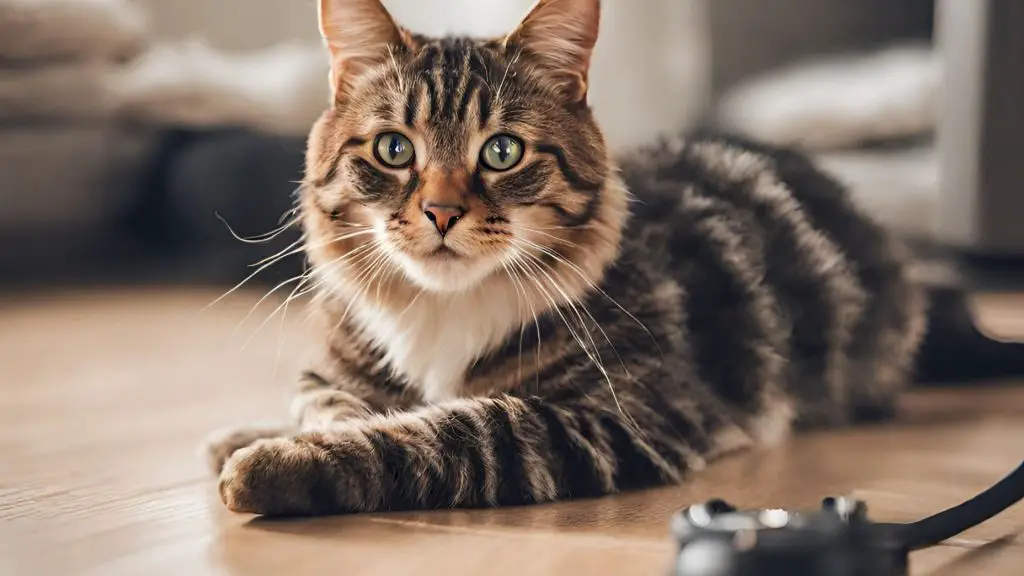Welcome to the persuasive world of feline mastery, where the time investment for cat training is not just about schedules but understanding your whiskered companion’s needs. Whether you’re a new cat parent or aiming to reinforce good habits in your furry friend, recognizing the cat’s training duration is critical for setting realistic goals.
Embarking on an effective cat training journey doesn’t come with a one-size-fits-all timeline. It requires an appreciation for your cat’s unique temperament and the specific skills you’re aiming to teach. Here, patience is not just a virtue, but a necessity. Let’s scratch the surface of this fascinating topic, and claw our way to a harmonious living with your well-trained feline friend.
Understanding Cat Behavior and Training Requirements

Delving into cat behavior is crucial for any pet owner seeking to develop an effective training regimen. Cats possess unique instincts and behaviors that greatly influence their responsiveness to feline training techniques. Understanding these inherent tendencies not only helps in tailoring training approaches but also ensures that the methods align with the cat’s temperament and preferences.
One of the fundamental differences when training a cat, compared to other animals, is their fiercely independent nature. Unlike dogs, cats are solitary hunters and this aspect of their personality can impact the type of training they respond to best. Tailoring training to fit this independent streak requires an approach that respects their autonomy while gently guiding their behavior.
To facilitate clarity for cat owners, below is a table highlighting the contrast between feline instincts and common training techniques that can address them:
| Cat Instinct | Training Technique | Outcome |
|---|---|---|
| Prey Drive | Play and Hunt Simulations | Channeling natural hunting instincts into controlled playtime |
| Need for Territory | Environmental Enrichment | Reducing territorial stress and preventing behavioral issues |
| Independence | Reward-Based Motivation | Encouraging desired behaviors through positive reinforcement |
| Nocturnal Activity | Evening Play Sessions | Adapting to the cat’s active hours for more effective training |
| Grooming Behaviors | Handling and Brushing Practice | Creating positive grooming experiences and reinforcing calm behavior |
By integrating awareness of cat behavior into feline training techniques, owners can not only improve the effectiveness of their training efforts but also strengthen their bond with their pets. It’s not just about understanding cats, it’s about appreciating their world and working within it to cultivate a harmonious living environment.
Getting Started with Kitten Training

Becoming a pet parent comes with the joyous task of guiding your little companions through their early stages of life. Kitten training is a delicate process that builds the foundation for a well-behaved adult cat. Acknowledging the crucial time frame for early cat training ensures that you are setting the stage for your pet’s future behavior and adaptability.
Age-Appropriate Training Methods
The formative weeks of a kitten’s life are integral to their development. Start with simple, gentle techniques that align with their growth stage. For instance, litter training can begin as soon as kittens start eating solid food, usually around the four-week mark. Socialization exercises should also be introduced at this tender age, gradually exposing them to various stimuli and gentle handling to acclimate them to different surroundings and touch.
The Best Time to Start Training Your Kitten
Capitalizing on a kitten’s innate curiosity and playfulness is key when deciding on the timing of training sessions. Training young cats during their peak periods of activity will result in more effective learning experiences. Kittens typically show high energy levels in the morning and evening; hence, scheduling short, engaging training activities during these times can yield the best results.
Let’s break down the key aspects of a kitten’s daily routine to determine the optimal training times:
| Activity | Peak Times | Training Opportunities |
|---|---|---|
| Feeding | Morning / Evening | Practice name recognition, and use treats for positive reinforcement |
| Playtime | Mid-morning / Late evening | Incorporate interactive toys to teach hunting and pouncing behaviors |
| Grooming | Post-meal / Pre-sleep | Acclimatize to brushing and handling, building trust and compliance |
| Sleep | Night / Various naps throughout the day | Establish quiet, safe sleeping areas to build routine and secure spaces |
Remember, the process of kitten training should be a gentle progression that fosters trust and reinforces positive behavior. With patience and understanding, your kitten will grow into a well-adjusted and trained companion.
The Basics of Obedience Training for Cats
Obedience training is not just for dogs—cats can also benefit from learning basic cat commands and it’s a key component of cat behavior modification. This form of training can enhance your connection with your feline friend, mitigate behavioral problems, and ensure their safety. Let’s explore how you can start teaching obedience commands to pave the way for a well-behaved cat.
Foundational Commands:
- Sit – Teaching your cat to sit is a fundamental command that can be built upon with more advanced training.
- Stay – This command is useful in keeping your cat safe, and it helps them learn self-control.
- Come – A vital command for recall, making sure your cat returns to you when needed.
Training a cat requires understanding that their motivation is different from other pets. Cats tend to respond better to positive reinforcement and short, engaging sessions.
| Command | Tips for Teaching | Expected Results |
|---|---|---|
| Sit | Use a treat to guide your cat into a sitting position, then give the treat as a reward. | Allows for calmer behavior during feeding or vet visits. |
| Stay | Gradually increase the distance and duration, rewarding your cat for remaining in place. | Improves impulse control and safety. |
| Come | Call your cat’s name followed by the command, reward them when they approach you. | Call your cat’s name followed by the command, and reward them when they approach you. |
Groundwork for further obedience training involves consistency, encouragement, and repetition. Always end training sessions on a positive note to ensure your cat associates them with fun and rewards. Remember, while obedience training may align with cat behavior modification, it’s also about bonding and communication, creating a trusting and long-lasting relationship with your feline companion.
Cats Training Techniques and Approaches

In the realm of feline companionship, the implementation of effective training techniques can significantly enhance the human-cat bond. Training should not be seen as mere obedience, but rather as a communication channel that promotes harmony and understanding between you and your cat. In this section, we’ll delve into the compelling world of positive reinforcement and clicker training to mold your cat’s behavior while fortifying your mutual relationship.
Positive Reinforcement: Rewards and Treats
The cornerstone of successful cat training is positive reinforcement. This method hinges on the principle of rewarding your cat for displaying behaviors you want to encourage. By offering treats or other rewards promptly following a desired action, you ignite a sense of achievement within your pet. Owners must pinpoint what rewards resonate most with their furry counterparts. Below is a detailed list of popular rewards:
- Edible Treats: Little morsels of food that are scrumptious, and healthy are often a hit.
- Playtime: Some felines prefer playing with a favorite toy over snacks.
- Affection: A gentle stroke or cuddle can be equally reinforcing.
The cat treats reward system forms a positive association with the behavior, encouraging your cat to repeat it in anticipation of another pleasant outcome. Do remember that moderation is key to preventing overfeeding and associated health issues.
Clicker Training: Shaping Cat Behavior
Clicker training for cats is a dynamic and interactive way to train. Essentially, a clicker is a small handheld device that emits a distinct ‘click’ sound when pressed. This sound serves as a consistent marker that immediately tells your cat they’ve done something correctly, closely followed by a reward. The preciseness and consistency of the click help your cat understand the exact moment they’ve performed the desired behavior. Here’s a simple table to guide you through the clicker training process:
| Step | Description | Tips for Success |
|---|---|---|
| 1. Introducing the Clicker | Familiarize your cat with the clicker’s sound without any commands. | Click and treat a few times to create a positive connection with the sound. |
| 2. Associating the Click | Click during the desired behavior and follow immediately with a treat. | Keep sessions short to maintain your cat’s attention. |
| 3. Shaping the Behavior | Gradually require more specific actions for the click and treat. | Be patient and build up complexity gradually. |
| 4. Adding a Cue | Introduce a verbal or visual cue before the desired behavior. | Choose distinct cues your cat can easily recognize. |
| 5. Practice and Patience | Repeat the process, slowly fading out the treats. | Reward intermittently to maintain behavior without constant treating. |
Consistency and timing are paramount when employing clicker training; the click must occur during the behavior, not before or after. This sharpens the learning curve, ensuring your cat associates the click with their action and the subsequent reward.
Through the application of positive reinforcement and clicker training, you can train your cat effectively while maintaining an environment of mutual respect and love. These methods not only teach your companion new tricks but also contribute to their overall well-being by providing mental stimulation and deepening the bond between you.
How to Teach Your Cat Tricks

Training cats to perform delightful cat tricks not only provides entertainment but also strengthens the bond between you and your feline friend. With a touch of patience and the right approach, fun cat training sessions can lead to significant moments of achievement. Here’s how to guide your cat through the learning process while ensuring it is an enjoyable experience for both of you.
- Start with the Basics: Begin by teaching simple commands such as ‘sit’ or ‘paw’. Use treats to motivate and reward.
- Keep it Short and Sweet: Cats have short attention spans, so training sessions should last no longer than 5-10 minutes.
- Incorporate Play: Turn training into a game. This keeps your cat engaged and makes learning more of an entertaining challenge.
- Use Positive Reinforcement: Always praise your cat and provide a treat or affection when they perform a trick correctly.
- Be Patient: Some cats may learn more quickly than others. Celebrate small victories and remain patient.
- Practice Regularly: Consistency is key. Practice tricks regularly to reinforce learning.
Remember, every cat is different and what works for one might not work for another. Tailoring your approach to your cat’s personality will make training cats to perform a seamless and gratifying process.
Training your cat to do tricks can be a wonderful way to spend quality time together, and it’s also great for your cat’s mental stimulation and physical exercise.
The excitement of learning new behaviors can be a deeply rewarding way to bond with your pet. So, go ahead and turn your cat tricks training sessions into a fun and gratifying experience that both you and your cat will cherish.
Addressing Behavioral Issues Through Training
Dealing with behavioral issues in cats can be a perplexing endeavor for many pet owners. Understanding the intricacies of feline psychology is pivotal when embarking on the journey of correcting cat misbehavior. Training, when conducted effectively, can be an invaluable tool in guiding cats toward better habits and social interactions.
Identifying the Root Causes of Misbehavior
Before we can address the behavioral issues in cats, it’s crucial to recognize their origins. Cats may exhibit signs of distress or misbehavior due to a variety of reasons, such as environmental stressors, medical problems, or lack of mental stimulation. Scrutiny of their daily routines and changes in their environment can unravel the mysteries behind their behaviors.
Using Training to Correct Unwanted Behaviors
Correcting cat misbehavior often requires a hands-on approach with a dash of patience. Cat behavioral training emphasizes the modification of undesirable actions through positive reinforcement and consistent guidance. Techniques such as redirecting attention and rewarding good behavior can lead to remarkable improvements over time. For issues that prove more complex, enlisting the help of a professional cat behaviorist or trainer might be the best course of action.
- Review the cat’s environment for potential stress triggers.
- Consultation with a veterinarian to rule out medical issues.
- Implement daily routines that include play, training, and relaxation.
- Introduce positive reinforcement to encourage preferred behaviors.
- Seek professional advice when conventional methods don’t resolve the problems.
Advanced Feline Training Techniques

For pet owners pursuing advanced cat training, the journey into more sophisticated techniques is both challenging and rewarding. It elevates the standard of interaction with your feline companion, introducing them to a broader range of skills that encourages both mental agility and physical prowess. Beyond the basic ‘sit’ or ‘paw’, teaching complex commands for cats can significantly enrich your cat’s life and enhance the bond you share.
Challenging Your Cat with Complex Commands
Embarking on advanced training, it’s crucial to recognize that introducing complex commands for cats requires patience and a step-by-step approach. These exercises are crafted to build on the trust and foundation established through previous training and demand a level of understanding and response above the norm.
- Begin with a command your cat knows well, and gradually augment it with additional steps or layers.
- Introduce the new commands in a quiet environment to minimize distractions and enhance focus.
- Use treats or clickers to mark desirable behavior clearly as you guide your cat through the learning process.
- Slowly phase out the treats, reinforcing the commands through repetition and positive reinforcement.
Witnessing your cat as they decipher and master these advanced tasks is a testament to the strength of continuous feline training. They don’t merely adapt; they thrive on the intellectual excitement that this level of training provides.
Maintaining Skills Over Time with Continuous Training
Advanced maneuvers and tricks should not only be taught but also consistently practiced to ensure their permanence in your cat’s repertoire. This concept of continuous feline training reaffirms commands and helps your cat retain their training long-term.
| Daily Practice | Weekly Challenges | Monthly Assessment |
|---|---|---|
| Review basic commands to maintain routine discipline. | Integrate new tricks or complex variations of known commands. | Assess progress and pinpoint areas that may need more focus or adjustment. |
| Short sessions to keep skills sharp without causing overstimulation. | Tactfully raising the difficulty level to gauge your cat’s adaptability and learning pace. | Adjust training complexity based on your cat’s responsiveness to maintain engagement. |
Ultimately, the goal of these sophisticated training routines is to forge a deep, communicative bond between you and your pet, one that transcends the normal interactions expected of cats and their owners. By dedicating time to continuous feline training, you create a fulfilling and dynamic environment for both you and your cherished companion.
Training Tips for Busy Cat Owners
For those who manage jam-packed schedules, finding time to train your feline friend can seem daunting. However, integrating cat training into your daily routine is simpler than you might think. By utilizing these training integration techniques, even the busiest cat owners can foster a well-behaved pet and strengthen their companionable bond.
Integrating Training into Everyday Life
Maximizing each interaction with your cat can turn into an opportunity for efficient cat training. Whether you’re using interactive toys during playtime or guiding your cat through routines, these moments can serve as short yet impactful training sessions. Feeding time, in particular, presents a prime chance to reinforce good behavior, such as sitting still while their food is being prepared.
Quick and Effective Training Sessions
Training doesn’t always have to be a lengthy process; short, concentrated bouts of training are often more effective. Consider these quick training tips for cat owners to help you utilize brief periods effectively:
- Focus on One Command: Choose a single command to work on and conduct five-minute sessions to practice it.
- Smart Rewards: Use your cat’s favorite treats to reward immediate responses, fostering a quick learning curve.
- Consistent Cues: Consistency with cues and rewards helps your cat understand and respond to training faster.
| Activity | Opportunity for Training | Tips for Efficiency |
|---|---|---|
| Feeding Time | Teaching Patience | Request your cat to sit before they’re served food to teach discipline. |
| Playtime | Reinforcing Commands | Incorporate commands like ‘come’ or ‘fetch’ while playing with toys. |
| Grooming | Handling Comfort | Use grooming time to get your cat comfortable with being touched. |
Remember, the key to successful cat training doesn’t lie in lengthy sessions but rather in regular, meaningful engagement. By being smart about when and how to offer training, you’ll find that your cat is learning and responding to your expectations more quickly than you expected.
Conclusion
As we’ve explored the various facets of feline education, it becomes clear that reinforcing positive feline behavior is a vital component of any successful training regimen. Key points to remember include acknowledging the spectrum of time required for success in cat training. From the age and distinct personality of your cat to the specific skills you aim to teach, each factor plays a crucial role in the time investment of your training endeavors.
Moreover, the merits of consistent, patient, and positive training tactics have been emphasized, and for good reason. These methods not only bolster the bond between you and your pet but also forge an environment where learning can thrive. As we wrap up this cat’s training guide, it is important to note that while each feline will progress at its own pace, perseverance is the cornerstone of any triumph in training.
In sum, the journey of feline training is marked by gradual steps and celebrated through incremental victories. We hope that this guide serves as a valuable roadmap, aiding both new and seasoned cat owners in nurturing well-behaved and happy companions. Remember, every cat is unique and so is their path to becoming a well-trained member of your family. Keep your approach as agile and loving as your feline friend, and the rewards will be ample for both of you.








